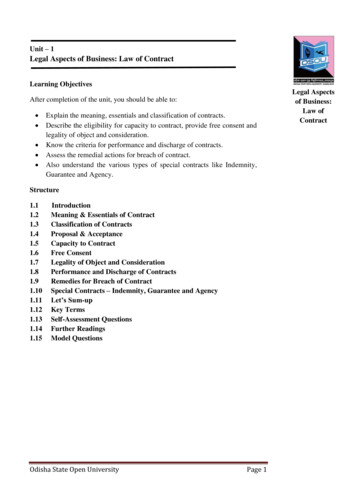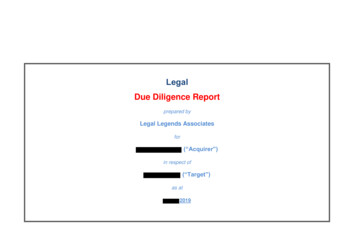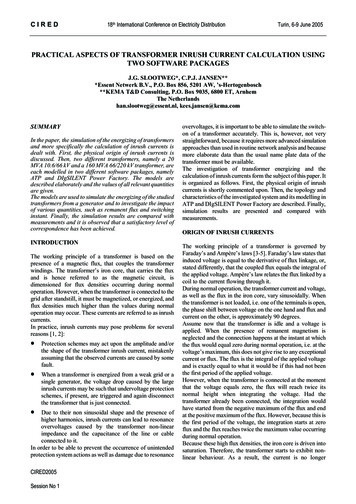
Transcription
Outline of Legal Aspects ofMergers and Acquisitionsin the United States15th Edition, September 2003Houston G London G Los Angeles G New York G Northern Virginia G Orange CountySacramento G San Diego G San Diego North County G San Francisco G Silicon ValleySydney G Taipei G Tokyo G Washington, DC
Outline of Legal Aspects of Mergers and Acquisitions in theUnited StatesIntroductionThis outline summarizes important aspects of United States law as it relates to mergers and acquisitions.It identified many significant issues relating to structuring and acquisition, including tax, accounting,corporate, securities, antitrust, trade regulation, environmental, intellectual property, insolvency, laborand employee benefits law. Any acquisition can also be expected to have unique legal concerns relatingto the particular businesses in which the subject companies are engaged. In commencing work on anyproposed acquisition, it is vital to involve counsel at an early stage to assist in identifying potential legalissues at a time when they are best resolved as well in structuring and negotiating the transaction.As acquisitions become increasingly transactional because of the relaxation of trade barriers, the growthin the number of companies seeking a worldwide market and the geographic diversity of acquisitiontargets, the need to address cross-border issues in even seemingly uncomplicated acquisitions continues toexpand. This Outline, now in its fifteenth edition, has grown accordingly so that its contents include theUnited States aspects of joint ventures, purchasing the business and/or assets of financially troubledcompanies and the regulation of foreign investment of ownership, and its distribution includes citizens ofcountries around the world. We welcome inquiries from the numerous individuals and organizations thatmake use of this Outline as to substantive matters and as to comments on how future editions can be mademore useful to you. Please address any comments or suggestions regarding the Outline to Stephen R.Rusmisel at (212) 858.1442 or Jerry P. Peppers at (212) 858.1205.The firm wishes to express its appreciation to Lynne R. Newofsky, Attorney-at-Law, in New York forpreparing the Immigration section and Kenneth Wilchfort of Ernst & Young in New York for preparingthe accounting section.While this Outline describes many issues common to acquisitions, it is not intended to be a treatise or toconstitute legal advice on any of these subjects. The Outline summarizes matters as of September 2003and will therefore not reflect changes and developments which occur thereafter.
Table of ContentsPageI.OVERVIEW OF LEGAL, STRUCTURAL, FINANCING AND OTHER CONSIDERATIONS. .1A. Legal and Structural Considerations.1B. Financing Considerations.1C. Other Considerations.1II.BASIC FORMS FOR STRUCTURING ACQUISITIONS. .1A. Statutory Merger or Consolidation.1B. Asset Purchase.3C. Stock Purchase.3D. Joint Venture.4E. Privatization. .6F. The Acquisition Agreement.7G. The Merger Agreement. .8III.TAX CONSIDERATIONS. .8A. Tax Free Reorganizations.8B. Taxable Transactions.12C. Hybrids and Variations on Basic Forms. .13IV.ACCOUNTING FOR BUSINESS COMBINATIONS.15A. Goodwill. .15B. Goodwill Impairment Testing. .15C. Intangible Assets Other than Goodwill.15D. Acquisitions of Less Than All of a Business.15V.FINANCING CONSIDERATIONS. .16A. Sources of Capital for Payment of Purchase Price. .16B. Earn-Outs. .18C. Regulatory Restrictions.19VI.AMERICAN DEPOSITARY RECEIPTS. .20A. Attributes .20B. Types of ADR Facilities. .21C. Advantages.21D. Legal requirements. .22VII.DUE DILIGENCE – IDENTIFICATION OF EXISTING AND CONTINGENT LIABILITIES. .23A. Purpose.23B. Participants. .23C. Objectives. .23D. Timing.23E. Review by Counsel.24VIII.TIMING. .25A. Friendly Transactions.25B. Unfriendly Transactions. .26IX.TENDER OFFERS. .26A. Federal Law.26B. Pre-Offer Purchases and Definition of Tender Offer. .31C. State Laws.33i
D.SEC Rules Relating to Tender Offers, Exchange Offers and Business Combinations Involving theSecurities of Foreign Private Issuers.35X.PROXY SOLICITATIONS. .39A. Federal Law.39B. State Law. .42C. Proxies and Voting. .42D. Stock Exchange Rules. .44E. Electronic Proxy Solicitation and Voting. .44F. Proxy Contests. .44XI.LEVERAGED BUYOUTS.44A. Definition. .44B. Considerations.44C. Legal Issues. .45XII.ACQUIRING OR SELLING BUSINESSES OR ASSETS OF FINANCIALLY TROUBLED COMPANIES. .48A. Acquiring or Selling Businesses or Assets of a Financially Troubled Company That is Not inBankruptcy.48B. Acquiring or Selling Businesses or Assets of a Debtor in Chapter 11.50C. Acquiring Control of a Chapter 11 Company through Purchasing Claims.53D. Tax Considerations.54XIII.STATE CORPORATE LAW CONSIDERATIONS. .54A. Director Fiduciary Duties. .54B. Limited Liability Companies/Partnerships .55C. Business Judgment Rule.55D. Fairness Considerations. .56E. Transfer of Control. .57F. Elimination of Minority Interests.57XIV.TAKEOVER DEFENSE MEASURES.58A. Structural Defenses.58B. Common Responses to an Unsolicited Offer.59XV.FEDERAL AND STATE SECURITIES LAW CONSIDERATIONS. .59A. Securities Act of 1933. .59B. Securities Exchange Act of 1934.66C. Investment Company Act of 1940 (the “1940 Act”). .69D. Sarbanes-Oxley Act of 2002 .70E. Overview of State Securities Laws.71XVI.OVERVIEW OF FEDERAL ANTITRUST LAWS. .72A. Clayton Act. .72B. Sherman Antitrust Act.73C. Federal Trade Commission Act. .73D. Application to Foreign Commerce. The U.S. antitrust laws apply to U.S. interstate commerce, to U.S.import commerce, to U.S. export commerce (e.g. cartels in foreign nations intended to restrict theimportation of U.S. goods into those markets), and to other conduct, including mergers, withsignificant effects on U.S. interstate or foreign commerce. .73E. Merger Guidelines. .74F. Antitrust Guidelines for Collaborations Among Competitors.75G. Hart-Scott-Rodino Filing Requirements. .75XVII.REGULATION OF FOREIGN INVESTMENT OR OWNERSHIP. .81A. National Security Review of Foreign Acquisitions. .81B. Federal Reporting Requirements for Foreign Investors in the United States.84C. Key Sectors. .85D. State Regulation of Foreign Investment in the United States.91ii
XVIII.REGULATED INDUSTRIES. .91A. Electric and Gas Utilities. .91B. Insurance Companies. .93C. Banks, Savings Associations, and Holding Companies. .94D. Airlines and Other Transportation Carriers.98E. Television, Radio and Other Communications Properties – Federal Communications Commission. .98XIX.OTHER CONSIDERATIONS. .98A. Pension and Other Employee Benefit Plans. .98B. Environmental Matters. .104C. Product Liability.106D. Intellectual Property Matters.107E. Labor and Equal Employment Opportunity Matters. .108F. Immigration Matters.109G. Dispute Resolution Mechanisms. .110H. Stock Exchange and NASDAQ-NMS Considerations. .112I.European Union Considerations. .113iii
OUTLINEOFLEGAL CONSIDERATIONSRELATING TOMERGERS AND ACQUISITIONSIN THEUNITED STATESI.II.OVERVIEW OF LEGAL, STRUCTURAL, FINANCING AND OTHER CONSIDERATIONS.A.Legal and Structural Considerations. A number of factors must be considered before deciding upon eventhe most fundamental aspects of a transaction. For example, the tax advantages to an acquiror of a particularstructure may be outweighed by the possibility that the acquiror may assume significant contingentliabilities arising by reason of the structure, such as product liability or pension or environmental liabilities.B.Financing Considerations. In addition, the financing of a merger or acquisition can take a variety of forms,each with a number of differing legal consequences. The completion of financing arrangements andagreements regarding purchase price depends in part on the results of both business and legal due diligence.Because such due diligence review may not commence or be complete until after initial financing decisionsand purchase price agreements have been made, early consideration of alternative financing options andrelated legal consequences can provide the flexibility that is often necessary later for final negotiations ofthe purchase price and for satisfying the business and legal concerns of sellers, purchasers, lenders andinvestors.C.Other Considerations. From a legal standpoint, the most cost-effective and otherwise successful mergersand acquisitions result when parties involved in such transactions have some familiarity, before planning andnegotiating a transaction, with the many legal considerations relating to mergers and acquisitions.Inefficiency and significant costs can be avoided by reviewing and discussing these considerations withcounsel at an early stage. Our experience has shown that such timely review and discussion helps to (i)clarify and prioritize the objectives of a transaction; (ii) consummate a transaction in a timely manner; (iii)facilitate an efficient post-closing transition; and (iv) avoid disappointing and costly surprises about the valueof acquired assets or stock or unknown liabilities (either those assumed by an acquiror or retained by aseller).BASIC FORMS FOR STRUCTURING ACQUISITIONS. There are four basic forms for structuringacquisitions: (A) Merger or Consolidation; (B) Asset Purchase; (C) Stock Purchase; and (D) Joint Venture. Theseforms are summarized below, along with some observations regarding their relative advantages anddisadvantages. Also included is a brief summary of privatization as a form of cross-border acquisition. In additionto corporate considerations, tax and accounting consequences may also be critical in determining the structure of atransaction. (See III and IV below.)A.Statutory Merger or Consolidation. The terms “merger” and “consolidation” refer to the combination of twoor more corporations, limited liability companies, limited partnerships or partnerships upon the affirmativevote of the requisite stockholders, members, limited partners or partners, as applicable, of the constituententities, and the filing of a certificate in the jurisdiction(s) of incorporation, formation or organization, as thecase may be. Some states also permit the merger or consolidation of one or more corporations with one ormore limited liability companies, limited partnerships or partnerships. In a merger, the constituent entitiesare merged into one of the constituent entities, which is deemed to be the surviving entity of the merger. In aconsolidation, the entities are consolidated to form a new entity. The stock, membership interests, limitedpartnership interests or partnership interests, as the case may be, of the non-surviving entity’s(ies’)stockholders, members, limited partners or partners, as applicable, is converted into stock, membershipinterests, limited partnership interests, partnership interests of the surviving or resulting entity, cash or someother form of consideration set forth in such certificate as a matter of law. Upon completion, the survivingor resulting entity carries on the combined business and the other(s) cease(s) to exist in separate form. (See
III.A.2 and III.B.1 for a summary of the tax considerations involved in mergers and consolidations.)Following are some structural variations of statutory mergers of corporations:1.2.3.4.5.Direct Statutory Merger. Target is merged into acquiror and target’s stockholders receive stock, cash,debt, property, or a combination thereof, of acquiror.(a)State corporation laws generally do not permit a direct merger of a United States (“U.S.”) targetinto a foreign acquiror. Hence, most acquisitions using a foreign parent’s stock are effectedthrough a “triangular” merger with a U.S. subsidiary of the foreign parent as the acquiror.(b)Target is merged out of existence, which may be undesirable depending on the target’s industryor the extent to which the target holds real property, nonassignable assets (including specialfranchises, licenses, permits, and local qualifications to do business) or contracts which requirethe consent of third parties to any assignment. This constraint also applies to consolidations andto “forward triangular mergers” described below.Forward Triangular Merger. Target is merged into subsidiary (generally newly formed) of acquirorand target’s stockholders receive stock, cash, debt, property, or a combination thereof, of acquiror(subsidiary’s parent).(a)Results in the transfer of target’s business (both assets and liabilities) to a wholly-ownedsubsidiary of acquiror.(b)Permits control over jurisdiction of incorporation, and maximum flexibility in terms ofcertificate of incorporation and by-laws.(c)Target is merged out of existence with the consequences described in 1(b) above.Reverse Triangular Merger. Subsidiary of acquiror (generally newly formed) is merged into target,target’s stockholders receive stock, cash, debt, property, or a combination thereof, of acquiror(subsidiary’s parent) and shares of acquisition subsidiary are converted into shares of target.(a)Target becomes wholly-owned subsidiary of acquiror.(b)Target’s corporate identity is preserved, mitigating the consequences described in 1(b) above(but not effective to prevent contractual or other consequences triggered by a “change ofcontrol”).Advantages. Advantages of all three forms of merger and of consolidation:(a)Total acquisition, and no minority stockholders remain after the merger;(b)Generally, no sales tax or bulk sales problems arise although there may be sales tax problems insome states with direct statutory mergers or forward triangular mergers; and(c)Relatively simple documentation.Disadvantages. Disadvantages of all three forms of merger and of consolidation:(a)Acquiror must assume all liabilities of target (fixed and contingent, disclosed and undisclosed),but direct exposure of acquiror is limited in a triangular merger because such liabilities are of itssubsidiaries;(b)Warranties will not normally survive the merger (although stockholder commitments may beobtained where target is closely held or where a discrete number of stockholders own a majorblock, or part of the consideration may be held back either in the form of escrow or a contingentpayment for several years);(c)Stockholders of non-surviving corporations may have dissenters’ appraisal rights permittingthem to receive cash for their stock in an amount equal to an appraised market value set by acourt; and2
(d)B.Asset Purchase. An acquiror may also purchase either substantially all, or only a part, of the assets of acorporate target in return for stock, cash, debt, property or a combination thereof. Advantages anddisadvantages comparable to those described below generally also apply to a sale of assets by a limitedliability company (“LLC”), limited partnership or partnership.1.2.C.Mergers or consolidations of different types of entities may be complicated by or prohibitedunder the laws of some states.Advantages. In addition to the tax advantages noted in III below, there are the following advantagesto a purchase and sale of assets:(a)Can acquire all or only selected assets and all or only selected liabilities, whether contingent orotherwise (although, if substantially all assets are purchased, exclusion of liabilities may not beeffective, especially where the seller no longer has economic substance);(b)Can avoid dealing with minority stockholders in many circumstances;(c)Unless purchasing substantially all of the assets, no stockholder vote of target is required; and(d)Typically no appraisal rights for dissenting stockholders.Disadvantages. In addition to the tax disadvantages noted in III below, there are the followingdisadvantages to a purchase and sale of assets:(a)Corporate identity of target is not preserved for acquiror;(b)More complex documentation requiring assignment and conveyance instruments (causing, inmany instances, otherwise undisclosed problems to surface);(c)May require numerous consents to assignment of contractual rights, potentially causing delayand giving rise to additional costs;(d)May trigger acceleration of certain obligations and require prepayment of target’s indebtedness;(e)If significant amount of real estate is involved, transfer taxes, recording fees, etc. may besubstantial;(f)If intellectual property is registered in many jurisdictions, many assignments need to be filed;(g)Possible sales tax and bulk sales problems; and(h)If assets purchased and sold constitute “substantially all” of the assets of target, a stockholdervote of target is usually required.Stock Purchase. An acquiror may gain control over a target by purchasing stock from the target’sstockholders, rather than merging with the target or purchasing its assets. The acquiring corporation maynegotiate with individual stockholders or, if the target is a public company, it may make a tender offer. (SeeIX below.) Advantages and disadvantages comparable to those described below generally also apply in thecontext of a purchase and sale of membership interests in a LLC, limited partnership interests or partnershipinterests.1.Advantages. A stock purchase provides the following advantages:(a)Target’s corporate identity is preserved together with special franchises, licenses, permits andlocal qualifications to do business (other than those that may be affected by a change in control);(b)Generally, no sales tax or bulk sales problems;(c)Target’s contract rights will not be impaired (unless specific contractual provisions requireconsent to changes in control);(d)Relatively simple transaction when the target is closely held;(e)Can be implemented through an exchange offer if management opposes the transaction;3
2.D.(f)Where target is closely held, may implement hold back or escrow protection and can alsoprovide for “earn out” component of purchase price;(g)Even if acquiror is party to security documentation with an after-acquired property clause,target’s assets may remain free from such a lien;(h)It may be possible to avoid the need for the approval of the target’s board of directors; and(i)Simpler documentation because there is no need to transfer individual assets, rights andliabilities.Disadvantages. In addition to the tax disadvantages noted in III below, this structure has the followingdisadvantages:(a)May result in less than total acquisition with resulting minority stockholders, giving rise topossible future questions of fiduciary obligations to such stockholders; and(b)Target is acquired subject to all its liabilities, including any undisclosed liabilities.Joint Venture. Joint ventures are a common vehicle for combining business efforts, especially betweenentities from different countries. Joint ventures can provide a relatively low-cost means by which coventurers can share benefits from particular assets or advantages, such as technology, expertise, namerecognition, governmental contacts or f
As acquisitions become increasingly transactional because of the relaxation of trade barriers, the growth in the number of companies seeking a worldwide market and the geographic diversity of acquisition targets, the need to address cross-border issues in even seemi ngly uncompl











